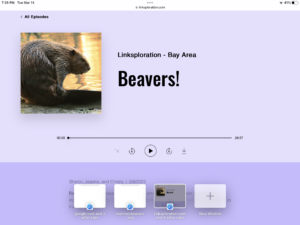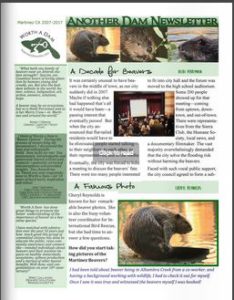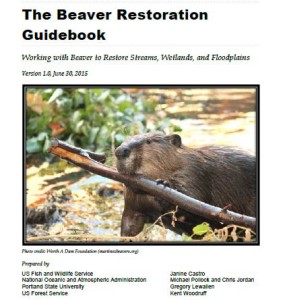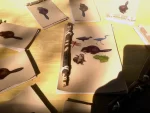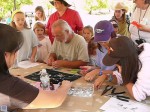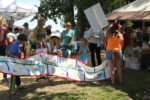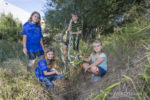
Well, I’m sure you’ll have plenty of other opportunities, but this is an important one. Before we get down to work and roll up our sleeves, let’s have dessert first.
About 20 DCR biologists and volunteers stomped to shake off the cold Sunday morning, standing in a ring outside a small shack on the Prescott Peninsula as Clark set the plan for the annual beaver survey. Teams would split off, tramp through the woods to follow their respective streams, take down data on any active beaver lodges, then return to the shack for lunch.
Beavers were non-existent in Massachusetts for more than a century due to hunting and trapping, plus elimination of habitat. After the valley was flooded in the late 1930s, the beavers returned.
Clark said that after the beavers came to the reservoir, the population followed a pattern typical of reintroduction — explosive growth, followed by a crash as the habitat is oversaturated, then a steady leveling off.
No way, are you suggesting that the population actually regulated itself? Without trapping? Even when the Massachusetts voters imposed new restrictions on trapping in 96 and the population was supposed to explode? This is pretty outlandish stuff. Just how long have you been collecting this spurious data?
The first Prescott survey was held in 1952. The survey has been annual since the early 1970s, and some of Sunday’s searchers have returned every year for 30-40 years.
Holy Guacamole Batman. You mean they have 62 years of data on beaver population? And the effect of conibear restriction is somewhere in the middle? You know a statistician worth his pocket calculator could easily whip those numbers into a regression analysis that disproves the accepted lie about beaver population exploding after the new rules were applied? You do know that, right?
Well, maybe the reporter got that wrong. He seemed really distracted by the meat balls. He does say that people aren’t normally allowed in the area because it’s in the watershed. Ahem. (News flash:Every place on this planet is part of a watershed. Just so you know.)
_________________________________________________________
Everyone ready? It’s November 18th so that means you still have 12 days left to tell Wildlife Services that their rodent management plan is ridiculous, oblivious of the environment or science, and barbaric in the extreme. But those are just my words. You’ll find your own. Here’s Mike Settel from Idaho talking about what’s needed.
In Wildlife Service’s newest justification for ridding us of beaver you can find that bit of humor and others in a recent request for public comment on Wildlife Service’s “Aquatic Rodent” EA for North Carolina.
Don’t attempt to e-mail your comments because, according to their deputy director for environmental compliance Alton Dunaway, receiving comments only by FAX and snail mail will “modernize” their public involvement process. I recommend Faxing comments to (919) 782-4159…However, an e-mail you may find useful is for that of the author, Barbara Schellinger.
Even though it is a North Carolina document, the rationale proposed sets a precedent for mis-information and obfuscation regarding wildlife management. Please FAX your comments and request that WS includes non-lethal mitigation as beaver solutions, provide current data showing beaver harm salmonids, and prove that beaver dams increase sediment pollution (there are other spurious claims that are suspect or dated, but you should read those for yourselves). Regards, Mike
Thanks Mike for putting us on the right track. Remember, what they get away with in North Carolina will become precedent everywhere. I will share just a little bit of their ignorance, but you should really go read the report for yourself here:
The Wisconsin Department of Natural Resources guidelines for management of trout stream habitat stated that beaver dams are a major source of damage to trout streams (White and Brynildson 1967, Churchill 1980). Studies that are more recent have documented improvements to trout habitat upon removal of beaver dams. Avery (1992) found that wild brook trout populations improved significantly following the removal of beaver dams from tributaries of some streams. Species abundance, species distribution, and total biomass of non-salmonids also increased following the removal of beaver dams (Avery 1992).
Beaver dams may adversely affect stream ecosystems by increasing sedimentation in streams; thereby, affecting wildlife that depend on clear water such as certain species of fish and mussels. Stagnant water impounded by beaver dams can increase the temperature of water impounded upstream of the dam, which can negatively affect aquatic organisms. Beaver dams can also act as barriers that inhibit movement of aquatic organisms and prevent the migration of fish to spawning areas.
Wow. Give it up for the USDA and author Barbara Schelllinger who was willing to dig back through 47 years of research to find the completely bogus paper she just knew to be true! This woman is no slacker when it comes to bravely lying about beavers. Good lord, the letter almost writes itself. Although I personally feel that Issue 7 deserves the lion’s share of our attention.
Therefore, the breaching or removal of a beaver dam could result in the degrading or removal of a wetland, if wetland characteristics exist at a location where a beaver dam occurs. The preexisting habitat (prior to the building of the dam) and the altered habitat (areas flooded by impounded water) have different ecological values to the fish and wildlife native to the area. Some species may benefit by the addition of a beaver dam that creates a wetland, while the presence of some species of wildlife may decline. For example, darters listed as federally endangered require fast moving waters over gravel or cobble beds, which beaver dams can eliminate; thus, reducing the availability of habitat. In areas where bottomland forests were flooded by beaver dams, a change in species composition could occur over time as trees die. Flooding often kills hardwood trees, especially when flooding persists for extended periods, as soils become saturated. Conversely, beaver dams could be beneficial to some wildlife, such as river otter, neotropical migratory birds, and waterfowl that require aquatic habitats.
 DingDingDing! I found the opening! (Well, one of many actually.) See in their effort to say “it’s a wash, really” beaver dams HELP some species sure, but they HARM others. So getting rid of them is a zero sum game with totally justifiable consequences. Just take the darter for instance!
DingDingDing! I found the opening! (Well, one of many actually.) See in their effort to say “it’s a wash, really” beaver dams HELP some species sure, but they HARM others. So getting rid of them is a zero sum game with totally justifiable consequences. Just take the darter for instance!
Darter!
Maybe we’re the only ones that remember there’s this famous case from Alabama in 2008 where the city of Birmingham was sued by The Department of Conservation and Natural Resources (among others) for upwards of a million dollars over removing this beaver dam that was protecting thousands of the rare endangered watercress darters. In the end the case cost the city some 4,000,000 dollars and dragged out in court over 4 years. Am I ringing any bells, does this sound vaguely familiar?
The city “knew or should have known that removing a beaver dam and surrounding natural structures would potentially disrupt the water level of the Basin and its inhabitants,” the agency claims.
 Dam [sic], this is gonna be fun. If you want to share your letters, send them to me and I’ll make sure they’re visible. I’m sure WS is hoping they can make it all the way to November 30th without hearing from you. Let’s disappoint them, shall we?
Dam [sic], this is gonna be fun. If you want to share your letters, send them to me and I’ll make sure they’re visible. I’m sure WS is hoping they can make it all the way to November 30th without hearing from you. Let’s disappoint them, shall we?

 ongratulations to Sarah Koenisberg who’s Beaver Believer film made it all the way to living on earth of NPR this week. Sarah and her crew were the documentary that filmed at the beaver festival 2 years ago, you might remember them hanging around at the time. Her film is sure to be thirstily received in the west, and I’m thrilled the Martinez Beavers were a part of it.
ongratulations to Sarah Koenisberg who’s Beaver Believer film made it all the way to living on earth of NPR this week. Sarah and her crew were the documentary that filmed at the beaver festival 2 years ago, you might remember them hanging around at the time. Her film is sure to be thirstily received in the west, and I’m thrilled the Martinez Beavers were a part of it.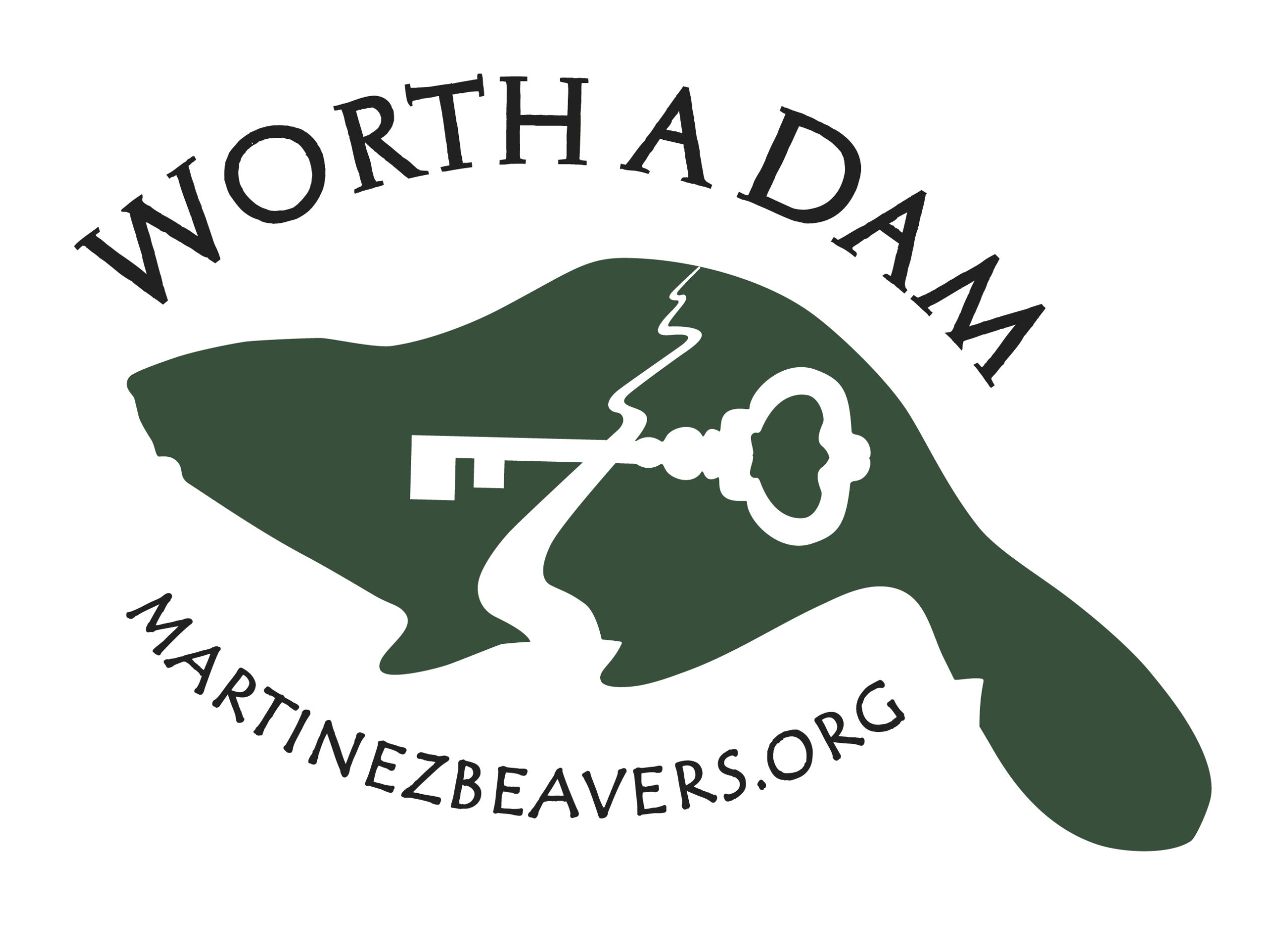






 Someone has been removing the wire mesh that protects trees in Vancouver’s Stanley Park from beavers, and the Stanley Park Ecology Society would like them to stop.
Someone has been removing the wire mesh that protects trees in Vancouver’s Stanley Park from beavers, and the Stanley Park Ecology Society would like them to stop.

 If you missed our exciting CT debut you can check out the
If you missed our exciting CT debut you can check out the 







